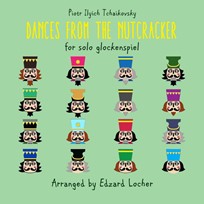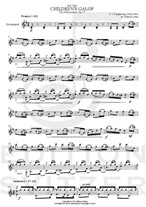
Dances from the Nutcracker
Composer: Pjotr Tjajkovskij
Instrument: Glockenspiel
Level: Advanced
Published: 2021
Price: €16.00
Item details
-
Description +
-
Preface
These arrangements are based on the orchestral score of the ballet (not the suite Op.71a) and the piano reduction written by the composer himself. Dynamics, execution orders and voicing are transferred as faithfully to the sources as possible but still had to be notably adapted to the specific istrumentation requirements of the glockenspiel at certain points.
The original has all repetitions written out in music. The repetitions indicated in this edition are for simplifaction only. In „Children’s Galop“ and „March“ repetitions have been cut by the arranger. Metronome numbers were provided by the arranger. No indications on sticking, choice of mallets or pedaling were added. Studying numbers weren’t adapted. Bar numbers refer to this edition and partially don’t fit those in the ballet.
Index
Act One
Overture
March
Children’s Galop
Harlequin and Columbina
Divertisment
Chocolate
Coffee
Tea
Trépak
Dance of the Reed Flutes
Mother Gigogne
Pas de Deux
Tarantella
Dance of the Sugar PlumFairy
Coda
-
-
Instrumentation +
-
Glockenspiel
-
-
Watch+
-
Performed by Edzard Locher
-
-
About the composer +
-
Pyotr Ilyich Tchaikovsky (25 April / 7 May 1840 – 25 October/6 November 1893), often anglicized as Peter Ilyich Tchaikovsky /ˈpiːtər .../, was a Russian composer of the late-Romantic period, some of whose works are among the most popular music in the classical repertoire. He was the first Russian composer whose music made a lasting impression internationally, bolstered by his appearances as a guest conductor in Europe and the United States. Tchaikovsky was honored in 1884 by Emperor Alexander III, and awarded a lifetime pension.
Although musically precocious, Tchaikovsky was educated for a career as a civil servant. There was scant opportunity for a musical career in Russia at that time and no system of public music education. When an opportunity for such an education arose, he entered the nascent Saint Petersburg Conservatory, from which he graduated in 1865. The formal Western-oriented teaching he received there set him apart from composers of the contemporary nationalist movement embodied by the Russian composers of The Five, with whom his professional relationship was mixed. Tchaikovsky's training set him on a path to reconcile what he had learned with the native musical practices to which he had been exposed from childhood. From this reconciliation, he forged a personal but unmistakably Russian style—a task that did not prove easy. The principles that governed melody, harmony and other fundamentals of Russian music ran completely counter to those that governed Western European music; this seemed to defeat the potential for using Russian music in large-scale Western composition or from forming a composite style, and it caused personal antipathies that dented Tchaikovsky's self-confidence. Russian culture exhibited a split personality, with its native and adopted elements having drifted apart increasingly since the time of Peter the Great. This resulted in uncertainty among the intelligentsia about the country's national identity—an ambiguity mirrored in Tchaikovsky's career.
Despite his many popular successes, Tchaikovsky's life was punctuated by personal crises and depression. Contributory factors included his early separation from his mother for boarding school followed by his mother's early death, the death of his close friend and colleague Nikolai Rubinstein, and the collapse of the one enduring relationship of his adult life, which was his 13-year association with the wealthy widow Nadezhda von Meck. His same-sex orientation, which he kept private, has traditionally also been considered a major factor, though some musicologists now downplay its importance. Tchaikovsky's sudden death at the age of 53 is generally ascribed to cholera; there is an ongoing debate as to whether cholera was indeed the cause of death, or if it was accidental or self-inflicted.
While his music has remained popular among audiences, critical opinions were initially mixed. Some Russians did not feel it was sufficiently representative of native musical values and expressed suspicion that Europeans accepted the music for its Western elements. In an apparent reinforcement of the latter claim, some Europeans lauded Tchaikovsky for offering music more substantive than base exoticism, and said he transcended stereotypes of Russian classical music. Others dismissed Tchaikovsky's music as "lacking in elevated thought," according to longtime New York Times music critic Harold C. Schonberg, and derided its formal workings as deficient because they did not stringently follow Western principles.
-
-
Reviews +
-
Review (Percussive Notes, June 2022)
We have all heard the dances from “The Nutcracker.” If you have prepared for percussion auditions, you have no-doubt practiced the cymbal part for the “Mirliton” movement, the tambourine part for the “Trepak,” or an excerpt from almost any part of the ballet. However, we never get the lead voice. German percussionist Edzard Locher has arranged selected movements from the ballet for glockenspiel to give us that opportunity.
This is a collection of the ten short dances that occur throughout the ballet, including the “March,” “Tea,” “Trepak,” and the “Dance of the Sugar Plum Fairy.” Aside from a reduction of repetitions in two of the pieces, each dance lines up with the subject material in terms of melody, implied harmony, and length.
To accommodate the range necessary to keep this level of authenticity on the glockenspiel, the performer will need a 3-octave instrument to accomplish the whole collection. even though not all the pieces require such a range. For example, “Children’s Gallop” and “Chocolate” can fit on most standard box/table glockenspiels. The arranger recommends that the instrument have a dampener pedal, assumingly because there are so many notes for each hand that there are rare ideal moments for hand dampening to occur.
Only one of the pieces requires four mallets. The “Arabian Dance,” also known as “Coffee,” calls for denser harmonies and metered one-handed tremolos that make four mallets necessary. This is also the dance that sounds the most like the original version due to its incorporation of thicker sonorities.
Locher designed the other works to be playable with two mallets. This does not lessen their difficulty level, however. He still incorporates lines of accompaniment for one hand while the other hand plays the melodic material. Depending on the piece, the secondary material can occur above the range of the melody, below it, or both. So one of the key challenges of this collection is being able keep the accompaniment at an appropriate dynamic so as to not overwhelm the listener with a cacophony of bell sounds. When done correctly, this creates an impressive version of these works with an added music-box characteristic that represents them in a new and appealing way.
The only movements that lose the authenticity from the original are the “Tarantella” and the “Coda.” In both movements, some of the original bass accompaniment did not make it into the glockenspiel arrangement, so some downbeats are left as rests. This causes the feeling of the dance to be momentarily lost until the next downbeat is played.
Locher took on an impressive undertaking, and the results are magnificent. The glockenspiel is lacking in repertoire, and this is a welcome addition to a growing collection of pieces that demonstrate the musical capabilities of the instrument.
—Kyle Cherwinski
-
-
Credits +
-
Front Cover Design: Nicola Lee
Photo: Christoph Risch
Engraving: Edzard Locher
Printed in Copenhagen, Denmark
Copyright © Edition SVITZER
www.editionsvitzer.com
-






